一、考题回顾
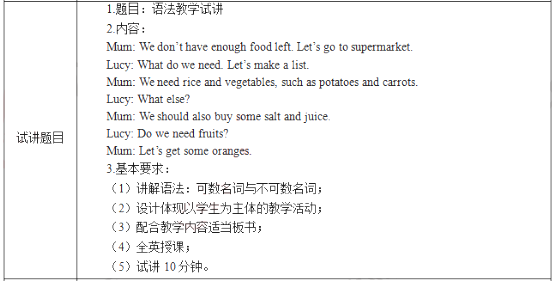
二、考题解析
【教案】
Countable and uncountable nouns
Teaching aims:
Knowledge aims:
Students will have a deeper understanding about nouns by dividing them into countable nouns and uncountable nouns..
Students will master the basic rules and some special cases of plural nouns, such as potatoes.
Ability aim:
Students will use nouns properly in their conversation.
Emotional aim:
Students will develop their leaning ability by inductive methods.
Key and difficult points:
Key point:
How to master the rules of plural nouns.
Difficult point:
How to use different nouns correctly in their daily life ;
Teaching procedures:
Step 1: Warming-up
1. Greetings and free talk about the food they ate in the morning.
2. Play a game called Find them different homes.
First, explain the rules: They need to classify the food in 2 or 3 groups in different ways and explain their reasons. For example, they can divide them into healthy food and junk food; vegetables and meat; Chinese food and western food; etc...
Second, divide them into groups 4.
Third, tell them to finish the job in 5 minutes.
Last, make a conclusion and introduce another way(plural and singular) to classify food and lead in to the topic.
Step 2: Presentation
1. Read the short passage for them and analyze the main idea together.
2. Ask them to underline words about food. And write down them on the blackboard in two groups. One includes food, rice, salt and juice. The other includes carrots, fruits and oranges.
3. Divide them into groups of 4 and ask them to find out the rules of the the words.
4. Explain that nouns can be divided into countable ones and uncountable ones. And countable one can be divided into plural and singular nouns.
5. Introduce some special cases, such as potatoes and tomatoes, and remind them we should add “es” at the end is the nouns are supposed to be plural.
Step 3: Practice
1. Activity one: Filling in the blanks: ask them to change the singular nouns into plural nouns. And invite a student to share his answers and give encouragements and corrections accordingly.
2. Activity two: Describing the pictures--they are different items with different numbers.
Step 4: Production
Activity: playing a game called Guessing who he is.
1. Explain the rules: they need to work in pairs. One describes any student in the class about their hair, clothes and glasses and and so on. The other one is supposed to guess the name. Then they exchange the roles.
2. Invite some groups to share their performance in front of the whole class.
Step 5: Summary and Homework
Summary: invite a student to be a little teacher and summarize today’s lesson. And make a conclusion: there are lots of words to learn, but if we master some rules, it will make learning more efficient.
Homework: ask them to find out 5 more nouns which have special plural forms.
Blackboard design:
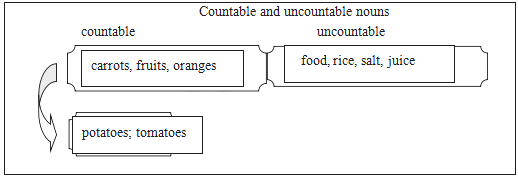
Teaching reflection
一、考题回顾
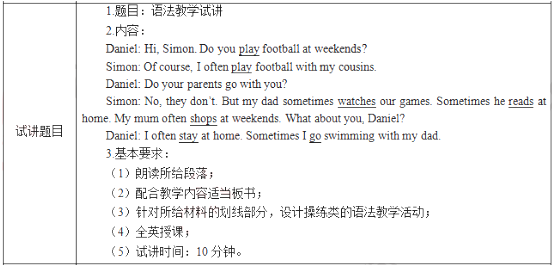
二、考题解析
【教案】
Simple present tense
Teaching aims:
Knowledge aim:
Students can understand the structure and usage of simple present tense.
Ability aim:
Students will develop their reading abilities of getting the main idea and main structure.
Emotional aim:
Students can be more interested in learning English and group work.
Key and difficult points:
Key point:
How to enable students to get familiar the key structure and usage of simple present tense.
Difficult point:
How to put simple present tense into daily life.
Teaching procedures:
Step 1: Warming-up
1. Greet with students.
2. Let students enjoy a song named Auld Lang Syne and ask them to sing together.
Should auld acquaintance be forgot,
And never brought to mind?
Should auld acquaintance be forgot,
And auld lang syne?
Ask students what’s this song about, and tell them this song is about friendship. And ask them what do they always do with their friends. Write down their answers on the blackboard.
Step 2: Presentation
1. Discovering
Invite students to read the conversation on the screen and conclude the main idea of it.
The main idea is what do Simon and his family members usually do.
Then they should circle the verbs and the adverbs of frequency.
2. Acquiring
Introduce the simple present tense to students by these examples. The structure is “subject + present tense of the verb”. And the function is to describe the action that occurs repeatedly, especially habits or hobbies.
Step 3: Practice
1. True or false
Present some sentences on the screen.
Q1: I always do exercises. (T)
Q2: He is do his homework right now. (F)
Q3: We sit here for more than 20 minutes. (F)
2. Make sentence
Play a game with them named “running pen”.
Give a pen to the student on the first line. They should pass the pen one by one. At the meanwhile the teacher will sing a song, when the song stops, the one who get the pen should make a sentence using the simple present tense.
Step 4: Production
Have a group discussion about what do their family members usually do in spare time. They will be given 5 minutes. And some process evaluation will be given during 5 minutes.
After that, some groups should come to stage and show their performance.
Step 5: Summary and Homework
Summary: invite a student to be a little teacher and summarize what they have learned today.
Homework: ask students to write down some sentences using the simple present tense.
Blackboard design:
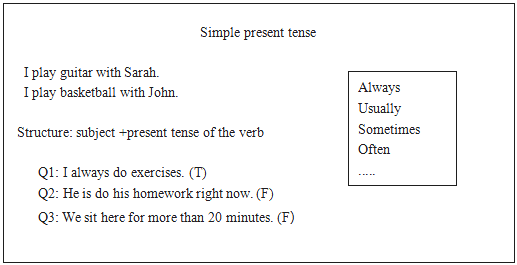
Teaching reflection
一、考题回顾
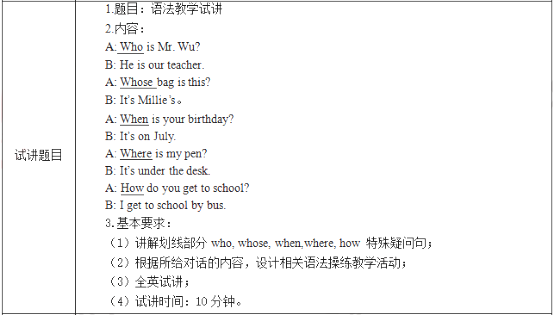
二、考题解析
【教案】
Special question
Teaching aims:
Knowledge aim:
Students can master the structure and function of special questions.
Ability aim:
Students will be able to grasp the structure of the knowledge through reading.
Emotional aim:
Students can be more eager of grammar learning.
Key and difficult points:
Key point:
How to get to know the target knowledge.
Difficult point:
How to foster the interest in grammar learning.
Teaching procedures:
Step 1: Warming-up
1. Greetings.
2. Let students enjoy a song called Stronger, and ask them what question they can hear from it. The song goes like this:
What doesn't kill you makes you stronger
Stand a little taller
Doesn't mean I'm lonely when I'm alone
What doesn't kill you makes a fire
Put that thing on lighter
Doesn't mean I'm over cause you're gone.
Ask students to answer the question and lead in the topic.
Step 2: Presentation
1 Ask students to read the passage, find the main idea and pay attention to the underlined words.
2. Write down the sentences with target grammar on blackboard and ask students to find out the similarities.
4. Introduce the grammar for the students.
Step 3: Practice
Ask students to chose the right words to fill in the blanks and use the special question to describe the picture on the screen one by one.
Step 4: Production
Ask students to work in 5 groups to make a dialogue about the daily routine of their school life. Five minutes later, some representatives will be invited to share. When making the dialogue, they should use what we learned today and pay attention to the intonation and pronunciation.
Step 5: Summary and Homework
Summary: invite a student to be a little teacher and summarize today’s lesson.
Homework: find out more words about special question and use them to make sentences.
Blackboard design:
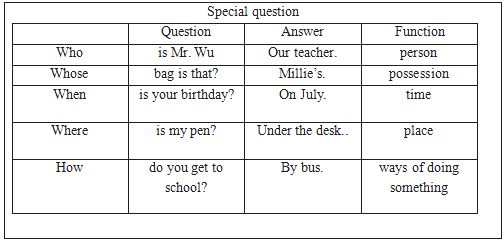
Teaching reflection
真题推荐:历年教师资格证面试真题>>>
教师资格证面试如何快速通关?233网校还原面试情景现场,助你一举攻下“结构化面试+试讲+答辩”三大内容,实战通关!试听课程>>
答疑解惑:添加小编微信个人号【ks233wx3】,或关注微信公众号【jiaoshi_233】搜索微信公众号“233网校教师资格证考试”,关注即可一对一答疑解惑!

